Different Physiological and Biochemical Responses of Bamboo to the Addition of TiO2 NPs under Heavy Metal Toxicity
Abstract
1. Introduction
2. Materials and Methods
2.1. Plant Material and Growth Conditions
2.2. Biomass and Shoot Length Determination
2.3. Antioxidant Activities
Hydrogen peroxide (H2O2), soluble protein (SP), and malondialdehyde (MDA) contents
2.4. Determination of Chlorophyll and Carotenoid Contents
2.5. Determination of TiO2 NP and Heavy Metal Accumulation in Bamboo Roots, Stems, and Leaves
2.6. Statistical Analysis
3. Results
3.1. Impact of the Combination of Different Concentrations of TiO2 NPs with 100 µM Cu and 100 µM Pb on Antioxidant Activities in Bamboo
3.2. Impact of the Combination of Different Concentrations of TiO2 NPs with 100 µM Cu and 100 µM Pb on Hydrogen Peroxide, Methylenedioxyamphetamine, and Soluble Protein Contents in Bamboo
3.3. Impact of the Combination of Different Concentrations of TiO2 NPs with 100 µM Cu and 100 µM Pb on the Contents of Chlorophyll-a, Chlorophyll-b, Total Chlorophyll and Total Carotenoids
3.4. Determination of TiO2 NP Accumulation and Heavy Metal Contents in Roots, Stems, and Leaves
3.5. Impact of the Combination of Various Levels of TiO2 NPs in Combination with 100 µM Cu and 100 µM Pb on the Root and Shoot Dry Weight and Shoot Length
4. Discussion
5. Conclusions
Supplementary Materials
Author Contributions
Funding
Institutional Review Board Statement
Informed Consent Statement
Data Availability Statement
Acknowledgments
Conflicts of Interest
References
- Puga, A.; Abreu, C.; Melo, L.; Beesley, L. Biochar application to a contaminated soil reduces the availability and plant uptake of zinc, lead and cadmium. J. Environ. Manag. 2015, 159, 86–93. [Google Scholar] [CrossRef]
- Zhang, X.; Zhong, T.; Liu, L.; Ouyang, X. Impact of Soil Heavy Metal Pollution on Food Safety in China. PLoS ONE 2015, 10, e0135182. [Google Scholar] [CrossRef]
- Bouazizi, H.; Jouili, H.; Geitmann, A.; El Ferjani, E. Copper toxicity in expanding leaves of Phaseolus vulgaris L.: Antioxidant enzyme response and nutrient element uptake. Ecotoxicol. Environ. Saf. 2010, 73, 1304–1308. [Google Scholar] [CrossRef]
- Jouili, H.; Bouazizi, H.; Rossignol, M.; Borderies, G.; Jamet, E.; El Ferjani, E. Partial purification and characterisation of a copper induced anionic peroxidase from sunflower roots. Plant Physiol. Biochem. 2008, 46, 760–767. [Google Scholar] [CrossRef]
- Lyer, S.; Sengupta, C.; Velumani, A. Lead toxicity: An overview of prevalence in Indians. Clin. Chim. Acta 2015, 451, 161–164. [Google Scholar]
- Dao, L.H.D.; Beardall, J. Effects of lead on two green microalgae Chlorella and Scenedesmus: Photosystem II activity and heterogeneit. Algal Res. 2016, 16, 150–159. [Google Scholar] [CrossRef]
- Salazar, M.J.; Rodriguez, J.H.; Cid, C.V.; Pignata, M.L. Auxin effects on Pb phytoextraction from polluted soils by Tegetesminuta L. and Bidens pilosa L.: Extractive power of their root exudates. J. Hazard. Mater. 2016, 5, 63–69. [Google Scholar] [CrossRef] [PubMed]
- Mohammadi, R.; MaaliAmiri, R.; Abbasi, A. Effect of TiO2 nanoparticles on chickpea response to cold stress. Biol. Trace Elem. Res. 2013, 152, 403–410. [Google Scholar] [CrossRef] [PubMed]
- Feizi, H.; Moghadam, P.R.; Shahtahmassebi, N.; Fotovat, A. Impact of bulk and nanosized titanium dioxide (TiO2) on wheat seed germination and seedling growth. Biol. Trace Elem. Res. 2012, 146, 101–106. [Google Scholar] [CrossRef]
- Singh, D.; Kumar, S.; Singh, S.C.; Lal, B.; Singh, N.B. Applications of liquid assisted pulsed laser ablation synthesized TiO2 nanoparticles on germination, growth and biochemical parameters of Brassica oleracea var. Capitata. Sci. Adv. Mater. 2012, 4, 522–531. [Google Scholar] [CrossRef]
- Mohammadi, R.; Maali-Amiri, R.; Mantri, N.L. Effect of TiO2 nanoparticles on oxidative damage and antioxidant defense systems in chickpea seedlings during cold stress. Russ. J. Plant Physiol. 2014, 61, 768–775. [Google Scholar] [CrossRef]
- Yang, F.; Hong, F.; You, W.; Liu, C.; Gao, F.; Wu, C.; Yang, P. Influence of nano-anatase TiO2 on the nitrogen metabolism of growing spinach. Biol. Trace Elem. Res. 2006, 110, 179–190. [Google Scholar] [CrossRef]
- Mingyu, S.; Huiting, L.; Chao, L.; Chunxiang, Q.; Lei, Z.; Fashui, H. Promotion of nano-anatase TiO2 on the spectral responses and photochemical activities of D1/D2/Cyt b559 complex of spinach. Spectrochim. Acta Part A Mol. Biomol. Spectrosc. 2009, 72, 1112–1116. [Google Scholar]
- Zheng, L.; Hong, F.; Lu, S.; Liu, C. Effect of nano-TiO2 on strength of naturally aged seeds and growth of spinach. Biol. Trace Elem. Res. 2005, 104, 83–92. [Google Scholar] [CrossRef]
- Singh, J.; Lee, B.K. Influence of nano-TiO2 particles on the bioaccumulation of Cd in soybean plants (Glycine max): A possible mechanism for the removal of Cd from the contaminated soil. J. Environ. Manag. 2016, 170, 88–96. [Google Scholar] [CrossRef]
- Yang, W.W.; Miao, A.J.; Yang, L.Y. Cd2+ Toxicity to a green alga Chlamydomonas reinhardtii as influenced by its adsorption on TiO2 engineered nanoparticles. PLoS ONE 2012, 7, e32300. [Google Scholar] [CrossRef]
- Khodakovskaya, M.V.; de Silva, K.; Biris, A.S.; Der Vishi, E.; Villagarcia, H. Carbon nanotubes induce growth enhancement of tobacco cells. ACS Nano 2009, 6, 2128–2135. [Google Scholar] [CrossRef]
- Li, F.M.; Zhao, W.; Li, Y.Y.; Tian, Z.J.; Wang, Z.Y. Toxic effects of nanoTiO2 on Gymnodinium breve. Environ. Sci. 2012, 33, 233–238. [Google Scholar]
- Gao, J.; Xua, G.; Qian, H.; Liu, P.; Zhao, P.; Hu, Y. Effects of nano-TiO2 on photosynthetic characteristics of Ulmus elongata seedlings. Environ Pollut. 2013, 176, 63–70. [Google Scholar] [CrossRef]
- Emamverdian, A.; Ding, Y.; Mokberdoran, F.; Ahmad, Z.; Xie, Y. Determination of heavy metal tolerance threshold in a bamboo species (Arundinaria pygmaea) as treated with silicon dioxide nanoparticles. Glob. Ecol. Conserv. 2020, 24, e01306. [Google Scholar] [CrossRef]
- Emamverdian, A.; Ding, Y.; Mokhberdoran, F.; Ahmad, Z.; Xie, Y. The Investigation of TiO2 NPs Effect as a Wastewater Treatment to Mitigate Cd Negative Impact on Bamboo Growth. Sustainability 2021, 13, 3200. [Google Scholar] [CrossRef]
- Yao, W.; Li, C.; Lin, S.; Ren, L.; Wan, Y.; Zhang, L.; Ding, Y. Morphological Characteristics and Transcriptome Comparisons of the Shoot Buds from Flowering and Non-Flowering Pleioblastus pygmaeus. Forests 2020, 11, 1229. [Google Scholar] [CrossRef]
- Yang, Q.; Duan, Z.; Wang, Z.; He, K.; Sun, Q.; Peng, Z. Bam-boo resources, utilization and ex-situ conservation in Xishuang-banna, South-eastern China. J. For. Res. 2008, 19, 79–83. [Google Scholar] [CrossRef]
- Huang, Z.; Jin, S.; Guo, H.; Zhong, X.; He, J.; Li, X.; Jiang, M.; Yu, X.; Long, H.; Ma, M.; et al. Genome-wide identification and characterization of TIFY family genes in Moso Bamboo (Phyllostachys edulis) and expression profiling analysis under dehydration and cold stresses. PeerJ 2016, 4, e2620. [Google Scholar] [CrossRef] [PubMed]
- Huang, W.; Reddy, G.V.P.; Li, Y.; Larsen, J.B.; Shi, P. Increase in Absolute Leaf Water Content Tends to Keep Pace with That of Leaf Dry Mass—Evidence from Bamboo Plants. Symmetry 2020, 12, 1345. [Google Scholar] [CrossRef]
- Hogarth, N.J.; Belcher, B. The contribution of bamboo to household income and rural live-lihoods in a poor and mountainous country in Guangxi, China. Int. For. Rev. 2013, 15, 71–81. [Google Scholar]
- Chen, R.; de Sherbinin, A.; Ye, C.; Shi, G. China’s soil pollution: Farms on the frontline. Science 2014, 344, 691. [Google Scholar] [CrossRef]
- Murashige, T.; Skoog, F. A Revised Medium for Rapid Growth and Bio Assays with Tobacco Tissue Cultures. Physiol. Plant. 1962, 15, 473–497. [Google Scholar] [CrossRef]
- Zhang, X. The Measurement and Mechanism of Lipid Peroxidation and SOD, POD and CAT Activities in Biological System. In Research Methodology of Crop Physiology; Agriculture Press: Beijing, China, 1992. [Google Scholar]
- Aebi, H. Catalase in vitro. Method. Enzymol. 1984, 105, 121–126. [Google Scholar]
- Nakano, Y.; Asada, K. Hydrogen peroxide is scavenged by ascorbate-spesific peroxidase in spinach chloroplast. Plant Cell Physiol. 1981, 22, 67–80. [Google Scholar]
- Cai, K.Z.; Gao, D.; Luo, S.M.; Zeng, R.S.; Yang, J.Y.; Zhu, X.Y. Physi-ological and cytological mechanisms of silicon-induced resistance in rice against blast disease. Physiol. Plantarum. 2008, 134, 324–333. [Google Scholar] [CrossRef]
- Bradford, M.M. A rapid sensitive method for the quan-tification of microgram quantities of protein utilising the principle of protein-Dye Binding. Anal. Biochem. 1976, 72, 248–254. [Google Scholar] [CrossRef]
- Kai, R.L.; Feng, C.H. Effects of brassinolide on drought resistance of Xanthoceras sorbifolia, seedlings under water stress. Acta Physiol. Plant. 2011, 33, 1293–1300. [Google Scholar]
- Lichtenthaler, H.K.; Buschmann, C. Chlorophylls and carotenoids: Measurement and characterization by UV–VIS spectroscopy. In Current Protocols in Food Analytical Chemistry; John Wiley & Sons, Inc.: Hoboken, NJ, USA, 2001; p. 4. [Google Scholar]
- Keller, A.A.; McFerran, S.; Lazareva, A.; Suh, S. Global life cycle releases of engineered nanomaterials. J. Nanopart. Res. 2013, 15, 1–17. [Google Scholar] [CrossRef]
- Sun, T.Y.; Gottschalk, F.; Hungerbühler, K.; Nowack, B. Comprehensive probabilistic modelling of environmental emissions of engineered nanomaterials. Environ. Pollut. 2014, 185, 69–76. [Google Scholar] [CrossRef]
- Afshan, S.; Ali, S.; Bharwana, S.A.; Rizwan, M.; Farid, M.; Abbas, F.; Ibrahim, M.; Mehmood, M.A.; Abbasi, G.H. Citric acid enhances the phytoextraction of chromium, plant growth 2 and photosynthesis by alleviating the oxidative damages in Brassica napus L. Environ. Sci. Pollut. Res. 2015, 22, 11679–11689. [Google Scholar] [CrossRef] [PubMed]
- Wuana, R.A.; Okieimen, F.E. Heavy metals in contaminated soils: A review of sources, chemistry, risks and best available strategies for remediation. ISRN Ecol. 2011. [Google Scholar] [CrossRef]
- Zia-ur-Rehman, M.; Sabir, M.; Rizwan, M.; Saifullah, U.; Ahmad, H.R.; Nadeem, M. Remediating cadmium-contaminated soils by growing grain crops using inorganic amendments. In Soil Remediation and Plants: Prospects and Challenges; Hakeem, K.R., Sabir, M., Ozturk, M., Murmet, A., Eds.; Elsevier Inc.: Amsterdam, The Netherlands; Academic Press: Cambridge, MA, USA, 2015; pp. 367–396. [Google Scholar]
- Foyer, C.H.; Noctor, G. Ascorbate and glutathione: The heart of the redox hub. Plant Physiol. 2011, 155, 2–18. [Google Scholar] [CrossRef] [PubMed]
- Hasanuzzaman, M.; Hossain, M.A.; da Silva, J.A.T.; Fujita, M. Plant Response and Tolerance to Abiotic Oxidative Stress: Antioxidant Defense Is a Key Factor. In Crop Stress and Its Management: Perspectives and Strategies; Venkateswarlu, B., Shanker, A., Shanker, C., Maheswari, M., Eds.; Springer: Dordrecht, The Netherlands, 2012. [Google Scholar]
- Ahmad, I.Z.; Ahmad, A.; Mabood, A.; Tabassum, H. Effects of Different Metal Stresses on the Antioxidant Defense Systems of Medicinal Plants. In Reactive Oxygen Species and Antioxidant Systems in Plants: Role and Regulation under Abiotic Stress; Khan, M., Khan, N., Eds.; Springer: Singapore, 2017. [Google Scholar]
- Lei, Z.; Mingyu, S.; Xiao, W. Antioxidant stress is promoted by nano-anatase in spinach chloroplasts under UV-B radiation. Biol. Trace Elem. Res. 2008, 121, 69–79. [Google Scholar] [CrossRef]
- Latef, A.A.H.; Srivastava, A.K.; Abd El-sadek, M.S.; Kordrostami, M.; Phan Tran, L.S. Titanium dioxide nanoparticles improve growth and enhance tolerance of broad bean plants under saline soil conditions. Land Degrad. Dev. 2018, 29, 1065–1073. [Google Scholar] [CrossRef]
- Khan, M.N. Nano-titanium Dioxide (Nano-TiO2) mitigates NaCl stress by enhancing antioxidative enzymes and accumulation of compatible solutes in tomato (Lycopersicon esculentum Mill.). J. Plant Sci. 2016, 11, 1–11. [Google Scholar] [CrossRef]
- Shakya, K.; Chettri, M.K.; Sawidis, T. Impact of Heavy Metals (Copper, Zinc, and Lead) on the Chlorophyll Content of Some Mosses. Arch. Environ. Contam. Toxicol. 2008, 54, 412–421. [Google Scholar] [CrossRef]
- Quartacci, M.F.; Cosi, E.; Navari-Izzo, F. Lipids and NADPH dependent superoxide production in plasma membrane vesicle from roots of wheat grown under copper deficiency or excess. J. Exp. Bot. 2001, 52, 77–84. [Google Scholar]
- Kovacik, P.; Hudec, J.; Ondrisik, P.; Poliakova, N. The effect of liquid Mg-Titanit on creation of winter wheat phytomass. Res. J. Agric. Sci. 2014, 46, 125–131. [Google Scholar]
- Ram, N.; Verloo, M.; Cottenie, A. Response of bean to foliar spray of titanium. Plant Soil. 1983, 73, 285–290. [Google Scholar] [CrossRef]
- Wang, W.N.; Tarafdar, J.C.; Biswas, P. Nanoparticle synthesis and delivery by an aerosol route for watermelon plant foliar uptake. J. Nanopart. Res. 2013, 15, 1417. [Google Scholar] [CrossRef]
- Rosenfeldt, R.R.; Seitz, F.; Schulz, R.; Bundschuh, M. Heavy metal uptake and toxicity in the presence of titanium dioxide nanoparticles: A factorial approach using Daphnia magna. Environ. Sci. Technol. 2014, 48, 6965–6972. [Google Scholar] [CrossRef]
- Luo, Z.; Li, M.; Wang, Z.; Li, J.; Guo, J.; Rosenfeldt, R.R.; Seitz, F.; Yan, C. Effect of titanium dioxide nanoparticles on the accumulation and distribution of arsenate in Daphnia magna in the presence of an algal food. Environ. Sci. Pollut. Res. 2018, 25, 20911–20919. [Google Scholar] [CrossRef]
- Pais, I. The biological importance of titanium. J. Plant Nutr. 1983, 6, 3–131. [Google Scholar] [CrossRef]
- Hara, T.; Sonoda, Y.; Iwai, I. Growth response of cabbage plants to transition elements under water culture conditions. Soil Sci. Plant Nutr. 1976, 22, 307–315. [Google Scholar] [CrossRef]
- Giménez, J.L.; Martinez-Sanchez, F.; Moreno, J.L.; Fuentes, J.L.; Alcaraz, C.F. Titanium in plant nutrition. III. Effect of Ti (IV) on yield of Capsicum annuum L. In Nutricion Mineral Bajo Condiciones de Estres; Barcelo, J., Ed.; SPIC-UIB: Palma de Mallorca, Spain, 1990; pp. 123–128. [Google Scholar]
- Kelemen, G.; Keresztes, A.; Bacsy, E.; Feher, M.; Fodor, P.; Pais, I. Distribution and intracellular localization of titanium in plants after titanium treatment. Food Struct. 1993, 12, 67–72. [Google Scholar]
- Wallace, A.; Alexander, G.V.; Chaudhry, F.M. Phytotoxicity of cobalt, vanadium, titanium, silver, and chromium. Commun. Soil Sci. Plant Anal. 1977, 8, 751–756. [Google Scholar] [CrossRef]
- Moaveni, P.; Kheiri, T. TiO2 Nano Particles Affected on Maize (Zea mays L.). In Proceedings of the 2nd International Conference on Agricultural and Animal Science, Maldives, 25–27 November 2011; IACSIT Press: Singapore, 2011; Volume 22, pp. 160–163. [Google Scholar]
- Morteza, E.; Moaveni, P.; Farahani, H.A.; Kiyani, M. Study of photosynthetic pigments changes of maize (Zea mays L.) under nano TiO2 spraying at various growth stages. SpringerPlus 2013, 2, 247. [Google Scholar] [CrossRef]
- Raliya, R.; Biswas, P.; Tarafdar, J.C. TiO2 nanoparticle biosynthesis and its physiological effect on mung bean (Vigna radiata L.). Biotechnol. Rep. 2015, 5, 22–26. [Google Scholar] [CrossRef]
- Raliya, R.; Nair, R.; Chavalmane, S.; Wang, W.N.; Biswas, P. Mechanistic evaluation of translocation and physiological impact of titanium dioxide and zinc oxide nanoparticles on the tomato (Solanum lycopersicum L.) plant. Metallomics 2015, 7, 1584–1594. [Google Scholar] [CrossRef]
- Moaveni, P.; Talebi, A.; Farahani, A.; Maroufi, K. Study of Nano Particles TiO2 Spraying on Some Yield Components in Barley (Hordem vulgare L.). In Proceedings of the International Conference on Environmental and Agriculture Engineering, Bangkok, Thailand, 5–7 June 2011; IACSIT Press: Singapore, 2011; Volume 15, pp. 115–119. [Google Scholar]
- Rafique, R.; Arshad, M.; Khokhar, M.; Qazi, I.; Hamza, A.; Virk, N. Growth response of wheat to titania nanoparticles application. NUST J. Eng. Sci. 2015, 7, 42–46. [Google Scholar]
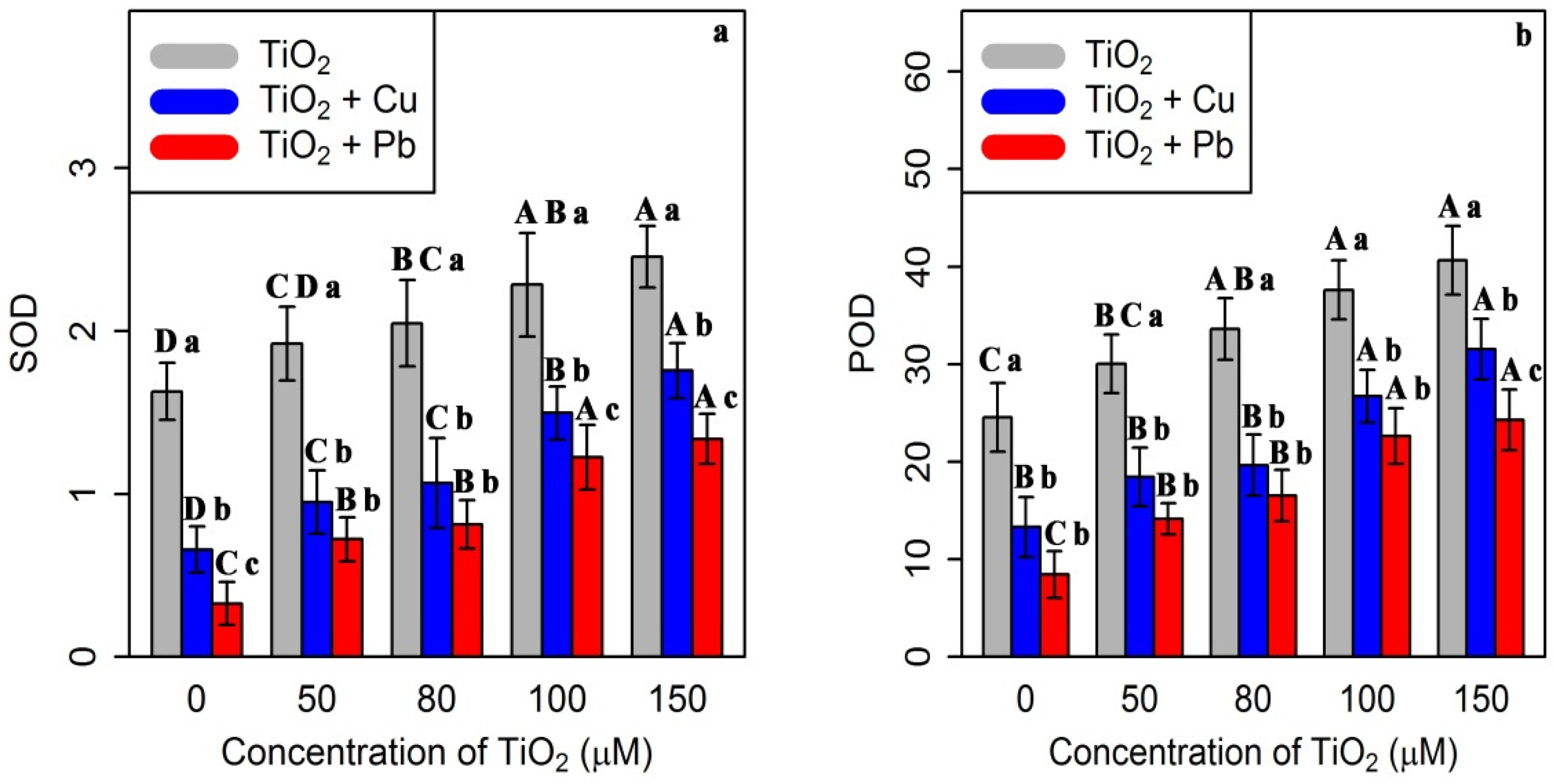
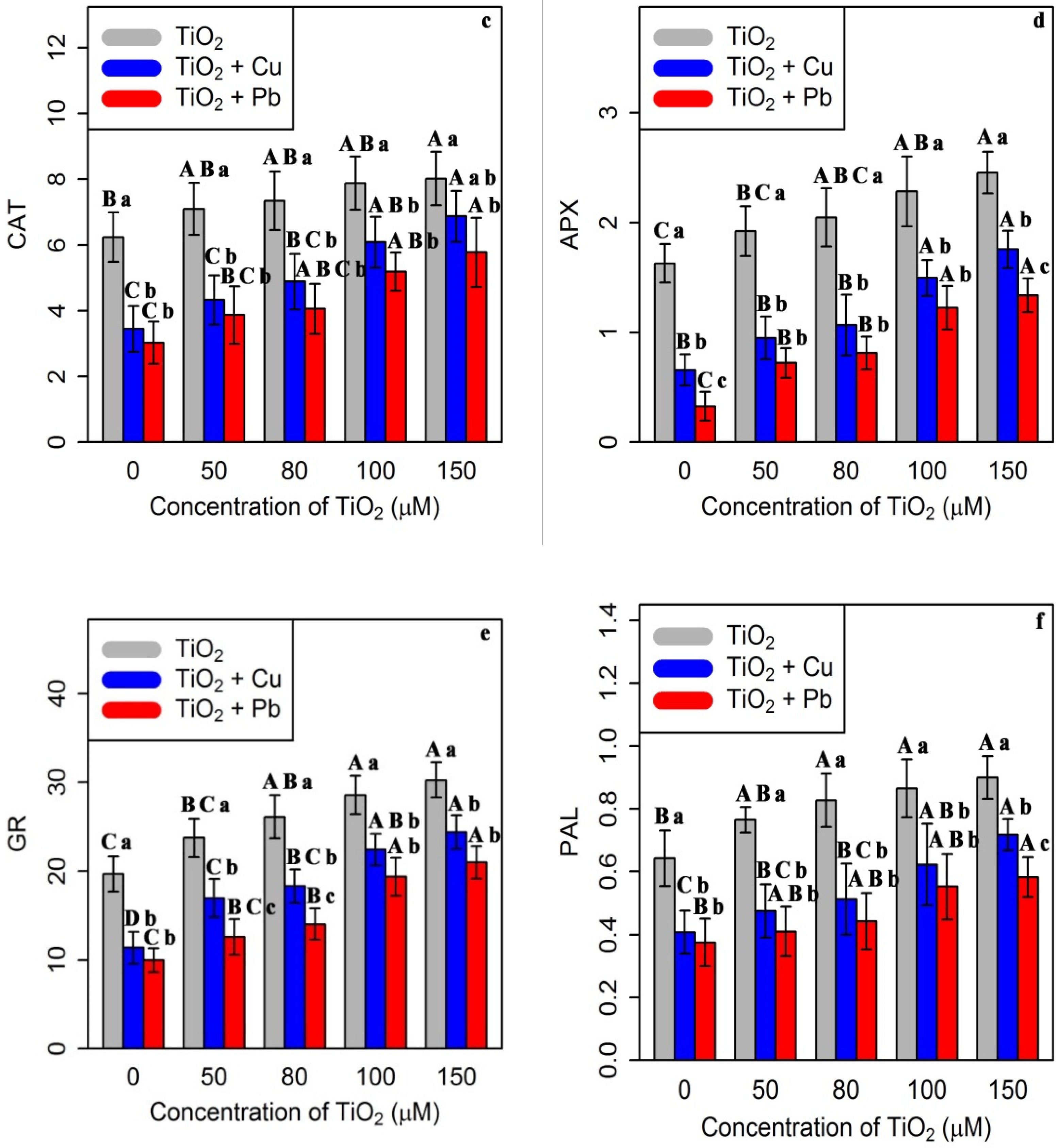
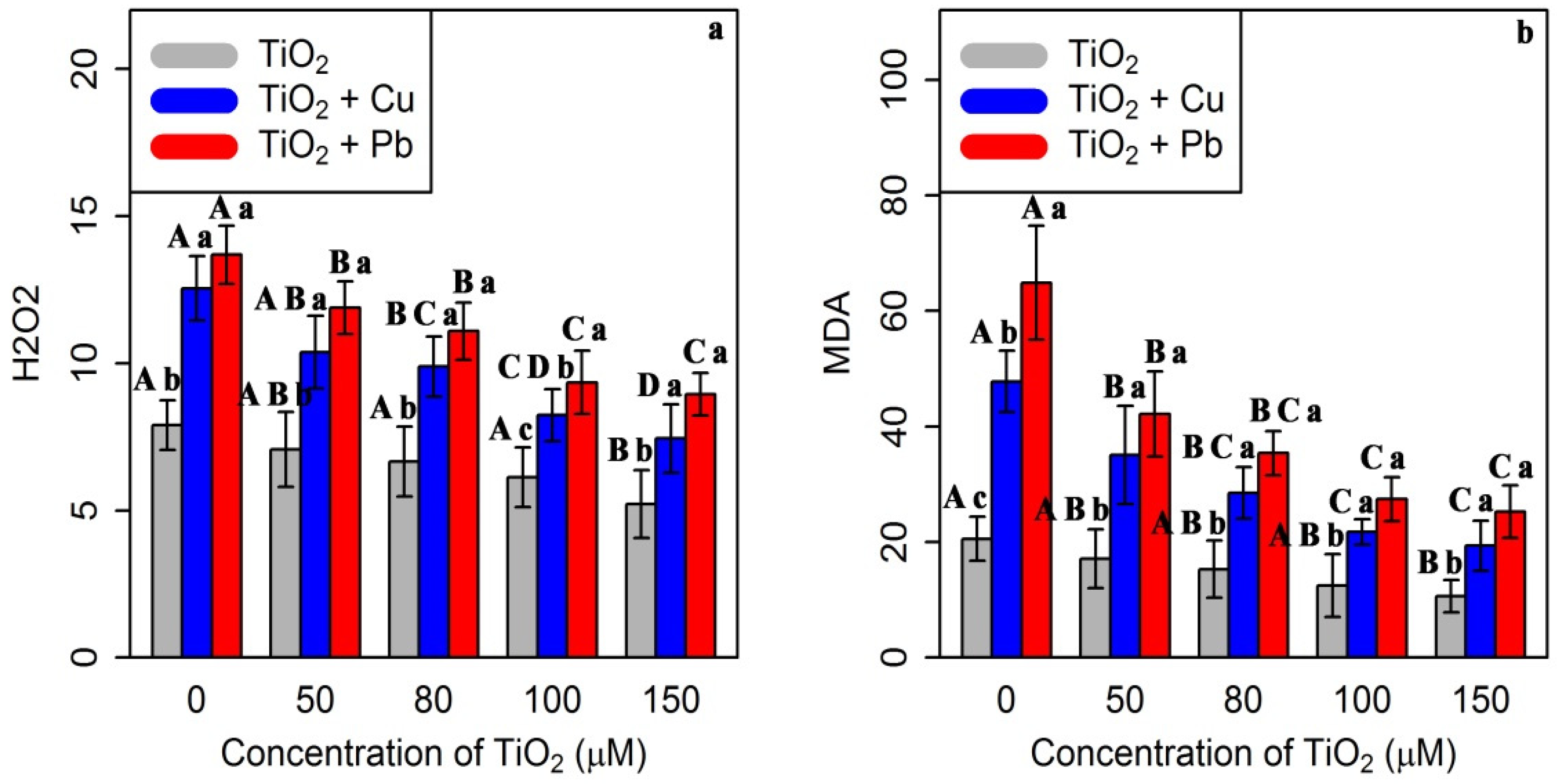
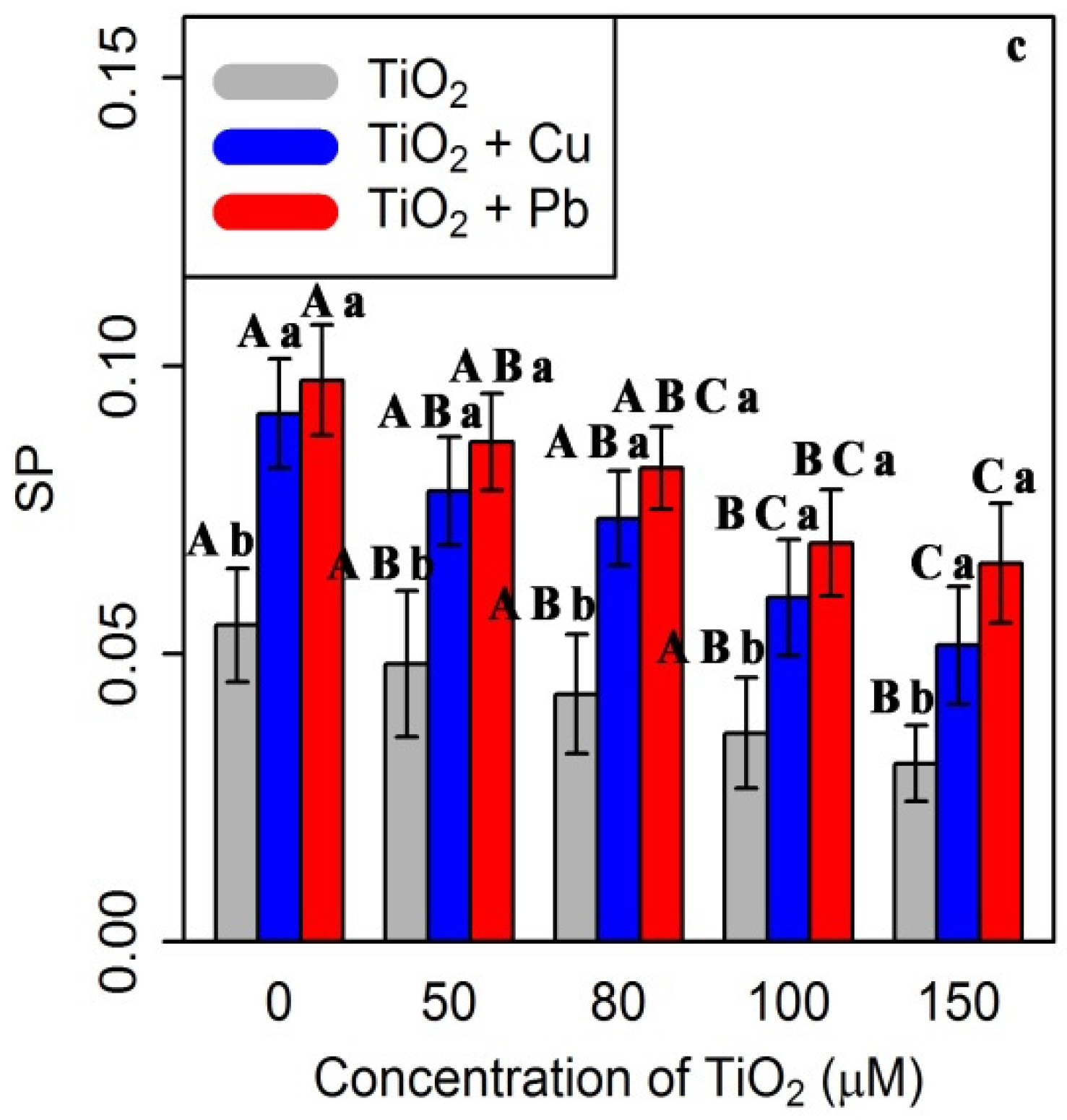
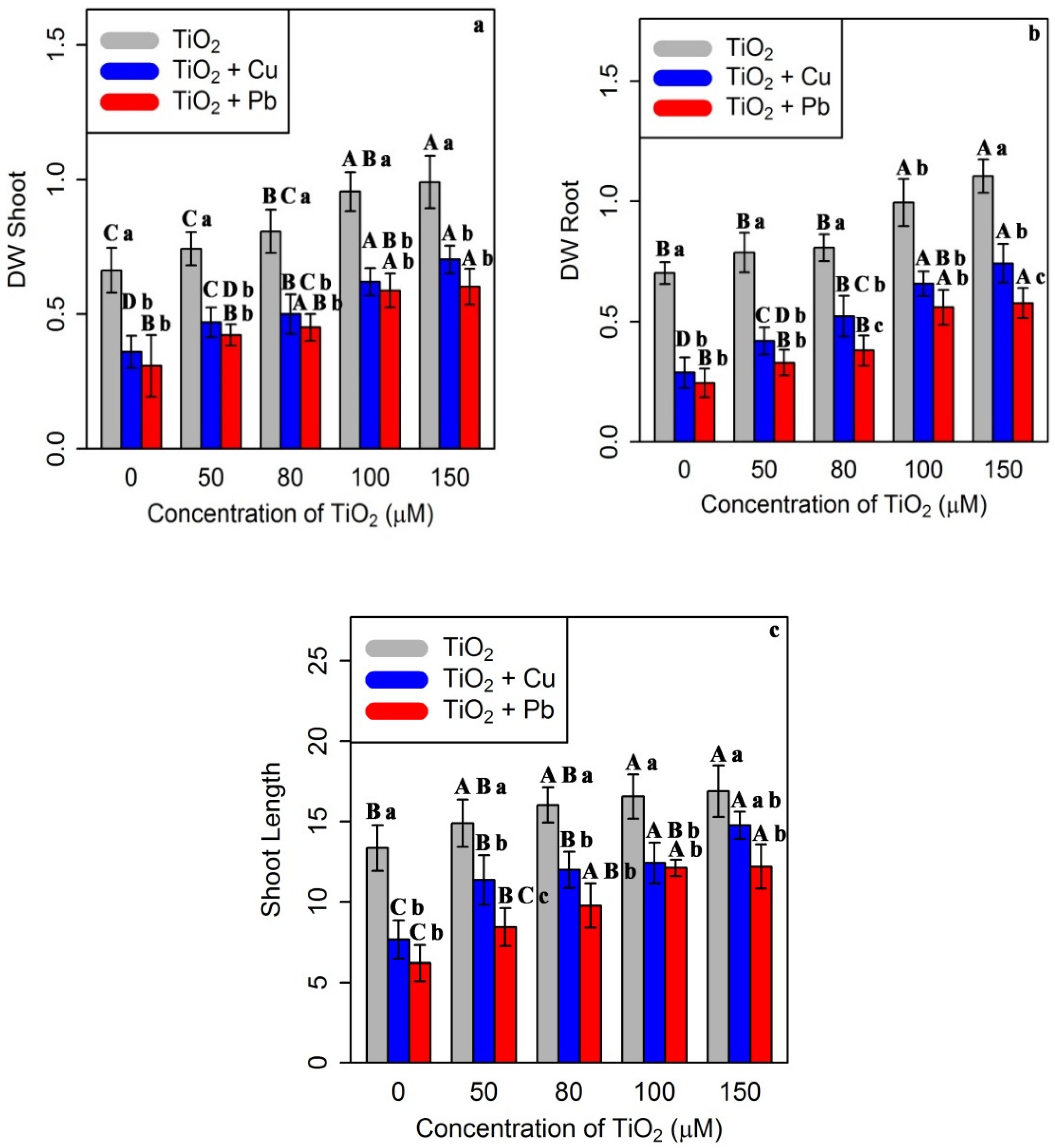
| Concentration of TiO2 NPs—100 µM (Cu and Pb) | SOD | POD | CAT | APX | GR | PAL | H2O2 | MDA | SP |
|---|---|---|---|---|---|---|---|---|---|
| 50 µM TiO2 NPs | 14.9% | 22.1% | 13.8% | 18.5% | 26.5% | 12.5% | 10.3% ↓ | 16.7% ↓ | 12.7% ↓ |
| 50 × 100 µM (Cu) | 53.1% | 38.4% | 25.4% | 46.1% | 47.7% | 17.5% | 17.3% ↓ | 26.6% ↓ | 14.2% ↓ |
| 50 × 100 µM (Pb) | 51.2% | 67.6% | 27.9% | 125% | 23.1% | 10.8% | 15.1% ↓ | 35.0% ↓ | 11.3% ↓ |
| 80 µM TiO2 NPs | 24.1% | 36.9% | 17.6% | 25.9% | 39.1% | 28.1% | 15.5% ↓ | 45.4% ↓ | 21.8% ↓ |
| 80 × 100 µM (Cu) | 80.4% | 47.8% | 42% | 64.1% | 56.8% | 25.7% | 21.2% ↓ | 40.4% ↓ | 19.7% ↓ |
| 80 × 100 µM (Pb) | 79.51% | 95.2% | 34.4% | 153% | 89.4% | 18.9% | 18.9% ↓ | 25.5% ↓ | 15.4.% ↓ |
| 100 µM TiO2 NPs | 36.1% | 53.2% | 26.2% | 40.7% | 52.6% | 34.3% | 22.4% ↓ | 39.4% ↓ | 34.5% ↓ |
| 100 × 100 µM (Cu) | 140% | 100% | 76.4% | 129% | 54.5% | 55.5% | 34.3% ↓ | 54.4% ↓ | 35.1% ↓ |
| 100 × 100 µM (Pb) | 140% | 168% | 71.7% | 281% | 102% | 48.6% | 31.7% ↓ | 57.7% ↓ | 28.8% ↓ |
| 150 µM TiO2 NPs | 48.9% | 65.6% | 28.6% | 51.2% | 61.1% | 40.6% | 33.9% ↓ | 48.3% ↓ | 43.6% ↓ |
| 150 × 100 µM (Cu) | 200% | 137% | 99.7% | 169% | 67.1% | 79.2% | 40.6% ↓ | 60.4% ↓ | 43.9% ↓ |
| 150 × 100 µM (Pb) | 174% | 187% | 90.7% | 315% | 128% | 56.7% | 34.6% ↓ | 60.4% ↓ | 32.9% ↓ |
| TiO2 NP Levels | Heavy Metals | Chl-a | Chl-b | T. Chl | Carotenoids |
|---|---|---|---|---|---|
| µM | µM | (µg g−1 F.w.) | (µg g−1 F.w.) | (µgg−1 F.w.) | (µg g−1 F.w.) |
| 0 | - | 8.89 ± 1.13 Ab | 4.30 ± 0.85 Ba | 13.10 ± 1.65 Ca | 0.38 ± 0.081 Ba |
| 0 | 100 µM Cu | 5.38 ± 0.66 Ab | 0.82 ± 0.08 Bb | 6.15 ± 0.67 Cb | 0.15 ± 0.088 Cb |
| 0 | 100 µM Pb | 5.13 ± 0.84 Ab | 0.31 ± 0.08 Cb | 5.46 ± 0.86 Cb | 0.127 ± 0.066 Bb |
| 50 µM | - | 9.10 ± 0.52 Aa | 5.63 ± 0.94 Ba | 14.51 ± 1.40 BCa | 0.46 ± 0.090 Ba |
| 50 µM | 100 µM Cu | 7.46 ± 0.94 Ab | 1.81 ± 0.83 Bb | 9.26 ± 0.79 Bb | 0.22 ± 0.079 BCb |
| 50 µM | 100 µM Pb | 6.00 ± 0.81 Ab | 1.19 ± 0.72 BCb | 7.19 ± 1.36 Cb | 0.185 ± 0.070 ABb |
| 80 µM | - | 9.26 ± 0.47 Aa | 8.30 ± 0.69 Ba | 17.28 ± 1.50 ABa | 0.59 ± 0.068 Aa |
| 80 µM | 100 µM Cu | 6.48 ± 0.90 Ab | 1.98 ± 0.83 Bb | 8.46 ± 1.50 BCb | 0.25 ± 0.087 ABCb |
| 80 µM | 100 µM Pb | 6.43 ± 0.39 ABb | 1.32 ± 0.88 BCb | 7.51 ± 1.33 BCb | 0.19 ± 0.071 ABb |
| 100 µM | - | 9.79 ± 0.79 Aa | 8.93 ± 1.39 Aa | 18.56 ± 2.20 Aa | 0.63 ± 0.094 Aa |
| 100 µM | 100 µM Cu | 8.05 ± 0.48 ABb | 4.20 ± 0.86 Ab | 11.95 ± 1.28 Ab | 0.36 ± 0.095 ABb |
| 100 µM | 100 µM Pb | 7.67 ± 0.53 Bb | 2.80 ± 0.81 ABb | 10.27 ± 1.56 ABb | 0.29 ± 0.087 ABb |
| 150 µM | - | 10.27 ± 0.81 Aa | 8.93 ± 1.13 Aa | 18.98 ± 2.12 Aa | 0.64 ± 0.082 Aa |
| 150 µM | 100 µM Cu | 7.85 ± 0.49 Bb | 4.91 ± 0.85 Ab | 13.02 ± 1.29 Ab | 0.42 ± 0.0818 Ab |
| 150 µM | 100 µM Pb | 7.57 ± 0.87 Bb | 3.67 ± 0.90 Ab | 11.22 ± 1.39 Ab | 0.33 ± 0.090 Ab |
| Leaves | |||
|---|---|---|---|
| Heavy Metal Concentration | TiO2 NP Concentration | Heavy Metal Concentration | Ti |
| µmol/L | µmol/L | µg/L | µg/L |
| 0 | 0 | 0 | 0 |
| 100 µmol/L Cu | 0 | 15.10 ± 0.62 Ab | 0 |
| 100 µmol/L Pb | 0 | 18.76 ± 0.87 Aa | 0 |
| 0 | 50 | 0 | 13.70 ± 0.71 Ca |
| 100 µmol/L Cu | 50 | 12.36 ± 0.28 Bb | 7.11 ± 0.43 Cb |
| 100 µmol/L Pb | 50 | 15.59 ± 0.84 Ba | 6.05 ± 0.47 Cb |
| 0 | 80 | 0 | 14.80 ± 0.46 Ca |
| 100 µmol/L Cu | 80 | 10.23 ± 0.29 Cb | 9.07 ± 0.51 Bb |
| 100 µmol/L Pb | 80 | 13.44 ± 0.86 Ca | 6.85 ± 0.46 Cc |
| 0 | 100 | 0 | 18.59 ± 0.41 Ba |
| 100 µmol/L Cu | 100 | 8.62 ± 0.29 Db | 10.95 ± 0.32 Ab |
| 100 µmol/L Pb | 100 | 11.44 ± 0.40 Da | 9.57 ± 0.35 Bc |
| 0 | 150 | 0 | 21.86 ± 1.32 Aa |
| 100 µmol/L Cu | 150 | 7.88 ± 0.52 Db | 11.13 ± 0.42 Ab |
| 100 µmol/L Pb | 150 | 10.83 ± 0.35 Da | 11.05 ± 0.55 Ab |
| Stem | |||
| µmol/L | µmol/L | µg/L | µg/L |
| 0 | 0 | 0 | 0 |
| 100 µmol/L Cu | 0 | 17.14 ± 0.88 Ab | 0 |
| 100 µmol/L Pb | 0 | 21.14 ± 0.60 Aa | 0 |
| 0 | 50 | 0 | 16.55 ± 0.44 Ca |
| 100 µmol/L Cu | 50 | 14.50 ± 0.82 Bb | 8.81 ± 0.49 Cb |
| 100 µmol/L Pb | 50 | 18.03 ± 0.51 Ba | 6.90 ± 0.54 Cc |
| 0 | 80 | 0 | 17.63 ± 0.61 Ca |
| 100 µmol/L Cu | 80 | 12.50 ± 0.65 Cb | 9.47 ± 0.46 Cb |
| 100 µmol/L Pb | 80 | 15.64 ± 0.31 Ca | 7.40 ± 0.34 Cc |
| 0 | 100 | 0 | 19.29 ± 0.58 Ba |
| 100 µmol/L Cu | 100 | 10.70 ± 0.57 Db | 11.40 ± 0.46 Bb |
| 100 µmol/L Pb | 100 | 13.56 ± 0.56 Da | 10.01 ± 0.45 Bc |
| 0 | 150 | 0 | 23.00 ± 0.82 Aa |
| 100 µmol/L Cu | 150 | 9.83 ± 0.73 Db | 14.02 ± 0.84 Ab |
| 100 µmol/L Pb | 150 | 12.80 ± 0.76 Da | 11.12 ± 0.15 Ac |
| Root | |||
| µmol/L | µmol/L | µg/L | µg/L |
| 0 | 0 | 0 | o |
| 100 µmol/L Cu | 0 | 20.24 ± 0.49 Ab | o |
| 100 µmol/L Pb | 0 | 24.56 ± 0.66 Aa | o |
| 0 | 50 | 0 | 19.39 ± 0.41 Da |
| 100 µmol/L Cu | 50 | 17.89 ± 0.73 Bb | 9.84 ± 0.52 Db |
| 100 µmol/L Pb | 50 | 21.43 ± 0.88 Ba | 7.85 ± 0.37 Cc |
| 0 | 80 | 0 | 22.91 ± 0.85 Ca |
| 100 µmol/L Cu | 80 | 16.31 ± 0.80 Cb | 11.90 ± 0.58 Cb |
| 100 µmol/L Pb | 80 | 19.13 ± 0.78 Ca | 9.56 ± 0.61 BCc |
| 0 | 100 | 0 | 25.17 ± 1.11 Ba |
| 100 µmol/L Cu | 100 | 14.12 ± 0.50 Db | 15.61 ± 0.45 Bb |
| 100 µmol/L Pb | 100 | 16.42 ± 0.45 Da | 12.06 ± 0.59 Ac |
| 0 | 150 | 0 | 30.84 ± 0.71 Aa |
| 100 µmol/L Cu | 150 | 13.77 ± 0.51 Db | 17.85 ± 0.57 Ab |
| 100 µmol/L Pb | 150 | 16.30 ± 0.67 Da | 13.08 ± 0.58 Ac |
| TiO2 NP Concentration | Heavy Metal Concentration | DW (Shoot) | DW (Root) | Shoot Length |
|---|---|---|---|---|
| µm | µm | g | g | cm |
| 50 | 0 | 12.1% | 12.1% | 11.5% |
| 50 | 100 µM Cu | 30.5% | 46.1% | 48.5% |
| 50 | 100 µM Pb | 37.3% | 34.6% | 35.9% |
| 80 | 0 | 21.8% | 14.9% | 20.12% |
| 80 | 100 µM Cu | 38.8% | 81.7% | 56.6% |
| 80 | 100 µM Pb | 46.3% | 55.1% | 57.6% |
| 100 | 0 | 44.1% | 41.6% | 24.01% |
| 100 | 100 µM Cu | 72.2% | 128% | 62.4% |
| 100 | 100 µM Pb | 91.1% | 128% | 95.4% |
| 150 | 0 | 49.4% | 57.2% | 26.5% |
| 150 | 100 µM Cu | 95.1% | 158% | 92.9% |
| 150 | 100 µM Pb | 95.9% | 135% | 96.8% |
Publisher’s Note: MDPI stays neutral with regard to jurisdictional claims in published maps and institutional affiliations. |
© 2021 by the authors. Licensee MDPI, Basel, Switzerland. This article is an open access article distributed under the terms and conditions of the Creative Commons Attribution (CC BY) license (https://creativecommons.org/licenses/by/4.0/).
Share and Cite
Emamverdian, A.; Ding, Y.; Mokhberdoran, F.; Ramakrishnan, M.; Ahmad, Z.; Xie, Y. Different Physiological and Biochemical Responses of Bamboo to the Addition of TiO2 NPs under Heavy Metal Toxicity. Forests 2021, 12, 759. https://doi.org/10.3390/f12060759
Emamverdian A, Ding Y, Mokhberdoran F, Ramakrishnan M, Ahmad Z, Xie Y. Different Physiological and Biochemical Responses of Bamboo to the Addition of TiO2 NPs under Heavy Metal Toxicity. Forests. 2021; 12(6):759. https://doi.org/10.3390/f12060759
Chicago/Turabian StyleEmamverdian, Abolghassem, Yulong Ding, Farzad Mokhberdoran, Muthusamy Ramakrishnan, Zishan Ahmad, and Yinfeng Xie. 2021. "Different Physiological and Biochemical Responses of Bamboo to the Addition of TiO2 NPs under Heavy Metal Toxicity" Forests 12, no. 6: 759. https://doi.org/10.3390/f12060759
APA StyleEmamverdian, A., Ding, Y., Mokhberdoran, F., Ramakrishnan, M., Ahmad, Z., & Xie, Y. (2021). Different Physiological and Biochemical Responses of Bamboo to the Addition of TiO2 NPs under Heavy Metal Toxicity. Forests, 12(6), 759. https://doi.org/10.3390/f12060759








